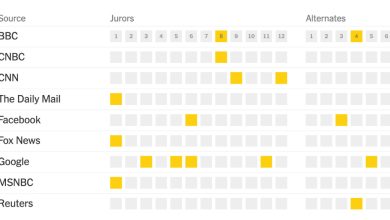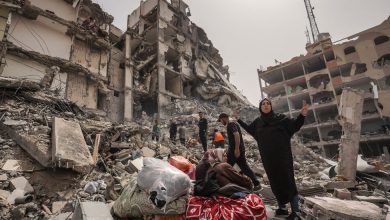Raising Crosswalks to Make Deadly Intersections Safer in New York

The white-striped crosswalk sits on top of a hump of asphalt.
Pedestrians barely notice as they rush across, but drivers are in for a bumpy ride if they do not slow down.
The crosswalk in northern Manhattan was raised four inches in the fall to try to slow traffic and make pedestrians more visible as they navigate a busy intersection where 26 people — including 14 pedestrians — have been injured in motor vehicle crashes in the past five years.
“People are always trying to get somewhere fast and beat the light,” said Amy Boysen, 44, a sales executive. “There is so much going on, and no one’s looking at the pedestrian.”
Now, Mayor Eric Adams wants to raise hundreds of crosswalks across New York amid a surge in traffic violence during the pandemic, in part because of an epidemic of speeding and reckless driving. Citywide, a total of 273 people — including 125 pedestrians — were killed in crashes last year, the highest number of traffic deaths since 2013, according to city records.
Since Mr. Adams took office in January, another 37 people — including 20 pedestrians — have been killed in crashes as of February 27th.
The surge in traffic fatalities has sharply reversed the gains made under former Mayor Bill de Blasio, whose signature transportation policy, called Vision Zero, once set a goal of eliminating all traffic deaths.
It also comes during a pandemic boom in cycling and e-mobility and outdoor dining that has brought more people into the streets even as traffic, which briefly disappeared when the city largely shut down, has returned.
Raised crosswalks have been shown to make streets safer elsewhere, but in New York, a city with roughly 40,000 intersections, there are just 17 of them.
Starting this year, however, the city plans to add 100 raised crosswalks every year as part of a broader effort to redesign some of New York’s most dangerous intersections — a particularly perilous piece of the streetscape where a majority of pedestrians are killed or injured.
City officials will also increase enforcement to catch drivers who fail to yield to pedestrians, a violation that became far less of a focus during the pandemic when police officials said the department was stretched thin because officers had fallen ill or been diverted to protests.
“We are taking everything we have done to a higher level,” said Ydanis Rodriguez, who was appointed the city’s transportation commissioner by Mr. Adams. “We are declaring intersections are sacred spaces and should be protected.”
Even before the pandemic, city officials had introduced measures to try to make streets safer, including lowering speed limits on high-crash thoroughfares, expanding automated speed cameras in school zones, re-timing walk signals to give pedestrians a head start and installing miles of protected bike lanes.
Still, New York, like other U.S. cities, has seen a jump in traffic deaths during the pandemic caused by speeding and dangerous driving brought on by lax police enforcement, emptier roads, more alcohol abuse and greater anxiety, according to traffic experts.
Many cities have increasingly turned to re-engineering crash-prone intersections, according to Alex Engel, a spokesman for the National Association of City Transportation Officials.
“The intersections are the hardest part of the street to design — they are where the most conflicts are,” said Mr. Engel, whose organization is helping cities apply for federal infrastructure funds to help pay for street redesigns.
Over the past five years in New York, more than half of all pedestrian and cyclist fatalities, and more than three-quarters of pedestrian and cyclist injuries, have taken place at intersections, according to city officials.
Caroline Shadood, 34, and her neighbors in Glendale, Queens, have repeatedly demanded safety improvements at the nearby intersection of Cypress and Cooper Avenues where they say drivers routinely speed and run red lights. There have been 70 people — including 10 pedestrians and seven cyclists — injured in motor vehicle crashes at that intersection in the past five years, city records show.
“It’s a known danger in the neighborhood,” Ms. Shadood said of the intersection.
A driver slammed into Ms. Shadood’s partner, Jon Burton, 35, and their dog, Tai, at the intersection a year ago, Ms. Shadood said. Both survived but Mr. Burton was left with a fractured hip and knees and could not work for months. (The dog had internal injuries to multiple organs.)
More recently, another pedestrian was knocked over at that intersection by one driver, and while lying on the ground, was run over by a second driver.
To better control traffic at the intersection, the city recently installed a so-called Barnes Dance, in which traffic signals are reprogrammed to temporarily stop all traffic, allowing pedestrians to cross safely in every direction at the same time.
The intersection, Mr. Rodriguez said, “has seen far too many crashes.”
City officials are working to redesign 1,000 dangerous intersections this year and also plan to target problem spots like parking lots and gas stations where drivers cut across sidewalks, in addition to raising scores of crosswalks.
Such “traffic calming measures” are crucial to slowing down drivers and preventing serious crashes, especially on busy streets where there is a mix of people driving, walking and biking, said Leah Shahum, the executive director of the Vision Zero Network, a nonprofit campaign that works with more than 45 cities across the country to make streets safer.
“They’re proven countermeasures,” she said. “What’s new is the political will to make these changes.”
Mr. de Blasio, who was often viewed by transportation advocates as being overly car-friendly, was accused of not moving aggressively enough to make streets safer. Advocates have generally been more positive about Mr. Adams, an avid cyclist, and Mr. Rodriguez, a former city councilman who was a frequent ally of transit advocates, though it is still early in the new administration.
N.Y.C. Mayor Eric Adams’s New Administration
Schools Chancellor: David Banks. The longtime New York City educator, who rose to prominence after creating a network of public all-boys schools, takes the lead at the nation’s largest public school system as it struggles to emerge from the pandemic.
Police Commissioner: Keechant Sewell. The Nassau County chief of detectives becomes New York City’s first female police commissioner, taking over the nation’s largest police force amid a crisis of trust in American policing and a troubling rise in violence.
Commissioner of Correction Department: Louis Molina. The former N.Y.P.D. officer, who was the chief of the Las Vegas public safety department, is tasked with leading the city’s embattled Correction Department and restoring order at the troubled Rikers Island jail complex.
Chief Counsel: Brendan McGuire. After a stint as a partner in a law firm’s white-collar practice, the former federal prosecutor returns to the public sector to advise the mayor on legal matters involving City Hall, the executive staff and administrative matters.
Transportation Commissioner: Ydanis Rodriguez. The Manhattan council member is a trusted ally of Mr. Adams. Mr. Rodriguez will face major challenges in his new role: In 2021, traffic deaths in the city soared to their highest level since 2013, partly due to speeding and reckless driving.
Health Commissioner: Dr. Ashwin Vasan. Dr. Dave A. Chokshi, the current commissioner, stays in the role to provide continuity to the city’s pandemic response. In mid-March, Dr. Vasan, the president of a mental health and public health charity, will take over.
Deputy mayors. Mr. Adams announced five women as deputy mayors, including Lorraine Grillo as his top deputy. Philip Banks III, a former N.Y.P.D. chief who resigned while under federal investigation in 2014, later announced his own appointment as deputy mayor for public safety.
Executive director of mayoral security: Bernard Adams. Amid concerns of nepotism, Mayor Adams’s brother, who is a retired police sergeant, will oversee mayoral security after he was originally named as deputy police commissioner.
“The focus of Vision Zero should be designing streets to prevent traffic violence before it even happens,” said Danny Harris, the executive director of Transportation Alternatives, an advocacy group.
Research studies have shown that raised crosswalks can increase the visibility of pedestrians and reduce traffic speeds and crashes, according to traffic engineers and experts. In New York, pedestrian injuries have typically declined after a raised crosswalk was installed, officials said.
Raised crosswalks are also popular because they can be relatively quick to install and inexpensive.
New York’s first raised crosswalk was placed in the Bronx in 2016, after a former city transportation official, Quemuel Arroyo, 32, spotted them while traveling in Mexico and Colombia.
Raised crosswalks, Mr. Arroyo said, are especially important for vulnerable street users — including people with disabilities and young children, who are sometimes not visible to drivers.
Mr. Arroyo, who uses a wheelchair and is now the chief accessibility officer for the Metropolitan Transportation Authority, said raised crosswalks “give me a heightened level of comfort knowing that motorists can see me.”
The new crosswalks, which will be financed with city and federal funding, will not be placed on major roads to avoid disrupting bus and truck routes, city officials said. Instead, they will be aimed at other intersections heavily used by pedestrians, especially children and older people, with many near schools, parks, playgrounds and senior centers.
Four new raised crosswalks have already been confirmed for Brooklyn, Queens, the Bronx and Staten Island.
In northern Manhattan, the raised crosswalk at 181st Street and Fort Washington Avenue was packed on a recent morning with subway commuters heading to a station, early risers clutching coffee cups and walking dogs and mothers and fathers pushing strollers.
A yellow sign alerts drivers to the raised crosswalk and warns them to slow down to 15 miles per hour on a street where the speed limit is 25 m.p.h.
Craig Clark, 38, who lives in Washington Heights and drives to an English-language teaching job in Queens, said that “it’s worth slowing down a little — that’s reasonable” but added that he would be concerned if raised crosswalks across the city significantly slowed traffic and made his commute, which already takes up to an hour, even longer.
But others like Glen Graham, 48, a podcast producer, said that even when he had a walk signal, many drivers still tried to cut him off. A raised crosswalk “would definitely help — there’s no way to speed over those bumps,” he said. “They have to slow down.”
Ms. Boysen, who said she has had close calls with cars while crossing the intersection, said the city needed many more raised crosswalks.
“I would love them everywhere,” she said. “We should be focusing more on keeping pedestrians safe.”




